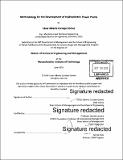Methodology for the development of hydroelectric power plants
Author(s)
Cornejo Gómez, César Alberto
DownloadFull printable version (9.946Mb)
Other Contributors
Massachusetts Institute of Technology. Engineering Systems Division.
Advisor
Donald Lessard.
Terms of use
Metadata
Show full item recordAbstract
Hydropower has sufficient resources available and is actively promoted by Governments as part of their energy matrix, but its development is constrained by the difficulty of addressing location particularities, including technical features such as geology or hydrology, and institutional features such as social acceptance, environmental constraints and the regulatory framework. Project results emerge from the interactions of these Inherent Features and the Project Architecture and do not always meet stakeholders' expectations, leading to deficient project results and lost value. This thesis proposes a methodology for prototyping projects to reflect these particularities and inform project shaping and decision-making early in the process. The proposed methodology was built on three systems engineering and project complexity frameworks, and lessons learned from four case studies. Its contribution to hydropower development is related to (i) the incorporation of systems evolution over time on the development process, (ii) the identification and management of relationships among the various decomposed elements of the development, (iii) the identification of emergent properties from the interactions among all features, (iv) a prototype for developers to optimize or search for project architectures that meet stakeholders objectives while complying with restrictions, (v) the delivery of unbiased information for decision-makers, (vi) the opportunity of stakeholders to participate in the project shaping in a continuous fashion, and (vii) the delivery of a tool for the implementation team to evaluate and challenge changes to the project during construction. The usage of this methodology does not guarantee the avoidance of errors or unforeseen project outcomes, but it does reduce the chance for unknown risks emerging from the interactions of the evaluated features.
Description
Thesis: S.M. in Engineering and Management, Massachusetts Institute of Technology, School of Engineering, System Design and Management Program, Engineering and Management Program, 2016. Cataloged from PDF version of thesis. Includes bibliographical references (pages 73-75).
Date issued
2016Department
Massachusetts Institute of Technology. Engineering and Management Program; System Design and Management Program.Publisher
Massachusetts Institute of Technology
Keywords
Engineering and Management Program., System Design and Management Program., Engineering Systems Division.